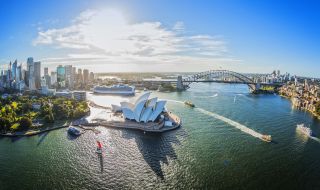

Cobar
Great Western Hotel, Cobar



Deep in the heart of central NSW you’ll find Cobar, aka ‘The Copper City’, once Australia’s largest producer of the mineral. At the crossroads of the Barrier Highway and Kidman Way, the town today pays homage to this history through fascinating museums and colonial buildings, preserved open-cut mines and memorials. Cobar is also the gateway to some of the state’s most interesting Aboriginal rock art.
Cobar’s riches were discovered in the late 1870s, when copper was found and the mineral put the region on the map. Back then, the Great Cobar Copper Mine was Australia’s leading producer of copper, with more than 2,000 workers operating the huge smelters and its 64-metre chimney stack. Today, remains of the smelter foundations are visible from the hill near the Great Cobar Museum.
For incredible panoramas of an open-cut mine and the town itself, head to the viewing platform at Fort Bourke Hill Lookout overlooking the New Cobar Gold Mine, Cobar's first gold mine.
Set inside the mine’s imposing administration building built in 1910, the Museum takes you on a journey through Cobar’s history from the time of the local Aboriginal people to the mining and agricultural era. Marvel at historic artefacts and take a seat at the controls of a massive excavator.
Just across the road is the Cobar Miners Heritage Park, an outdoor exhibit that takes you on a deeper dive into the town’s mining history. Across the lush grounds you’ll find a memorial to Cobar’s miners to honour those who lost their lives while at work. You’ll also find a two-metre bronze sculpture of a miner, a restored stamper battery from the Mount Boppy Mine, a loader from the CSA Mine, a head frame and winder from the Chesney Mine and the Miners Memorial bell tower.

Cobar Miners Heritage Park, Cobar
Follow the self-guided Cobar Heritage Walk to see the town’s historic buildings, including several from the Victorian and Edwardian eras, as well as early miners’ cottages. Then stop by the heritage-listed Great Western Hotel, a classic rural Australian corner pub with wide, shady verandahs and iron lacework. Peruse the historic photos that line the pub’s exterior, then drop in for a cool beverage and a chat with locals.

The Great Western Hotel, Cobar
At Mount Grenfell Historic Site, 70km from Cobar, you can visit an important art site created by the Ngiyampaa people thousands of years ago. You can reach the site via a short walk; when you reach the rocky overhang, marvel at richly coloured paintings of human and animal figures, representations of the natural environment, and hand stencils that are of ceremonial significance to traditional owners. Another more challenging hiking trail, Ngiyambaa Walking Track, takes you further into this gorgeous landscape of red dirt, mallee bushland, open grasslands and the rocky rise of Mount Grenfell itself. The scenic view from the summit, across this low-relief plain, is vast and wide.

Mt Grenfell Historic Site, Cobar area
In the warmer months, follow the lead of locals and head to the 'Old Res' to swim, kayak and fish, or stretch your legs on a stroll around the reservoir’s banks. More watersports await at the Newey Reservoir, a glorious waterway that attracts all manner of birdlife. Bring a rug and enjoy a picnic under a shady tree.
For something unexpected, visit the Cobar Sound Chapel. This permanent sound installation is set in an old disused water tank, created by renowned composer and sound artist Georges Lentz in collaboration with Pritzker-Prize-winning architect Glenn Murcutt, the musicians of The Noise String Quartet, as well as Cobar Indigenous visual artist Sharron Ohlsen. Expect to be wow-ed by this dramatic space, which unites music, architecture, art, poetry and nature.

Newey Reservoir, Cobar
It takes about eight hours to drive to Cobar from Sydney, seven hours from Canberra and nine hours from Melbourne. Alternatively, you can fly to Dubbo and hire a car for the three-hour drive. 4WD vehicles are recommended for unsealed roads and many of the national parks. There are a number of places to stay, such as motels and caravan parks.

Cobar Caravan Park, Cobar - Credit: Peter Bellingham
Stay connected to Visit NSW for all the latest news, stories, upcoming events and travel inspiration.
All the insider news, tips and inspiration you need to plan your next trip, delivered straight to your inbox.
Sign UpVisitNSW.com is the official tourism site for Destination NSW.
© Copyright 2025 Destination NSW. All rights reserved